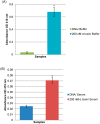In vitro selection of single-stranded DNA molecular recognition elements against S. aureus alpha toxin and sensitive detection in human serum
- PMID: 25633102
- PMCID: PMC4346865
- DOI: 10.3390/ijms16022794
In vitro selection of single-stranded DNA molecular recognition elements against S. aureus alpha toxin and sensitive detection in human serum
Abstract
Alpha toxin is one of the major virulence factors secreted by Staphylococcus aureus, a bacterium that is responsible for a wide variety of infections in both community and hospital settings. Due to the prevalence of S. aureus related infections and the emergence of methicillin-resistant S. aureus, rapid and accurate diagnosis of S. aureus infections is crucial in benefiting patient health outcomes. In this study, a rigorous Systematic Evolution of Ligands by Exponential Enrichment (SELEX) variant previously developed by our laboratory was utilized to select a single-stranded DNA molecular recognition element (MRE) targeting alpha toxin with high affinity and specificity. At the end of the 12-round selection, the selected MRE had an equilibrium dissociation constant (Kd) of 93.7 ± 7.0 nM. Additionally, a modified sandwich enzyme-linked immunosorbent assay (ELISA) was developed by using the selected ssDNA MRE as the toxin-capturing element and a sensitive detection of 200 nM alpha toxin in undiluted human serum samples was achieved.
Figures





Similar articles
-
Selection of Single-Stranded DNA Molecular Recognition Elements against Exotoxin A Using a Novel Decoy-SELEX Method and Sensitive Detection of Exotoxin A in Human Serum.Biomed Res Int. 2015;2015:417641. doi: 10.1155/2015/417641. Epub 2015 Nov 9. Biomed Res Int. 2015. PMID: 26636098 Free PMC article.
-
In Vitro Selection of a Single-Stranded DNA Molecular Recognition Element against the Pesticide Fipronil and Sensitive Detection in River Water.Int J Mol Sci. 2017 Dec 28;19(1):85. doi: 10.3390/ijms19010085. Int J Mol Sci. 2017. PMID: 29283416 Free PMC article.
-
In Vitro Selection of a Single-Stranded DNA Molecular Recognition Element against Clostridium difficile Toxin B and Sensitive Detection in Human Fecal Matter.J Nucleic Acids. 2015;2015:808495. doi: 10.1155/2015/808495. Epub 2015 Feb 5. J Nucleic Acids. 2015. PMID: 25734010 Free PMC article.
-
Current advances in aptamer-assisted technologies for detecting bacterial and fungal toxins.J Appl Microbiol. 2018 Mar;124(3):644-651. doi: 10.1111/jam.13650. Epub 2018 Jan 8. J Appl Microbiol. 2018. PMID: 29171901 Review.
-
Single-stranded DNA (ssDNA) production in DNA aptamer generation.Analyst. 2012 Mar 21;137(6):1307-15. doi: 10.1039/c2an15905h. Epub 2012 Feb 7. Analyst. 2012. PMID: 22314701 Review.
Cited by
-
Staphylococcal Enterotoxins: Description and Importance in Food.Pathogens. 2024 Aug 9;13(8):676. doi: 10.3390/pathogens13080676. Pathogens. 2024. PMID: 39204276 Free PMC article. Review.
-
Aptamers: A prospective tool for infectious diseases diagnosis.J Clin Lab Anal. 2022 Nov;36(11):e24725. doi: 10.1002/jcla.24725. Epub 2022 Oct 17. J Clin Lab Anal. 2022. PMID: 36245423 Free PMC article. Review.
-
In Vitro Selection and Characterization of a Single-Stranded DNA Aptamer Against the Herbicide Atrazine.ACS Omega. 2018 Oct 31;3(10):13576-13583. doi: 10.1021/acsomega.8b01859. Epub 2018 Oct 19. ACS Omega. 2018. PMID: 30411044 Free PMC article.
-
Selection, characterization, and biosensing applications of DNA aptamers targeting cyanotoxin BMAA.RSC Adv. 2024 Apr 26;14(20):13787-13800. doi: 10.1039/d4ra02384f. eCollection 2024 Apr 25. RSC Adv. 2024. PMID: 38681844 Free PMC article.
-
Selection of Single-Stranded DNA Molecular Recognition Elements against Exotoxin A Using a Novel Decoy-SELEX Method and Sensitive Detection of Exotoxin A in Human Serum.Biomed Res Int. 2015;2015:417641. doi: 10.1155/2015/417641. Epub 2015 Nov 9. Biomed Res Int. 2015. PMID: 26636098 Free PMC article.
References
-
- Mediavilla J.R., Chen L., Uhlemann A.C., Hanson B.M., Rosenthal M., Stanak K., Koll B., Fries B.C., Armellino D., Schilling M.E., et al. Methicillin-susceptible Staphylococcus aureus ST398, New York and New Jersey, USA. Emerg. Infect. Dis. 2012;18:700–702. doi: 10.3201/eid1804.111419. - DOI - PMC - PubMed
-
- Vandenesch F., Naimi T., Enright M.C., Lina G., Nimmo G.R., Heffernan H., Liassine N., Bes M., Greenland T., Reverdy M.E., Etienne J. Community-acquired methicillin-resistant Staphylococcus aureus carrying Panton-Valentine leukocidin genes: Worldwide emergence. Emerg. Infect. Dis. 2003;9:978–984. doi: 10.3201/eid0908.030089. - DOI - PMC - PubMed
-
- Moet G.J., Jones R.N., Biedenbach D.J., Stilwell M.G., Fritsche T.R. Contemporary causes of skin and soft tissue infections in North America, Latin America, and Europe: Report from the SENTRY Antimicrobial Surveillance Program (1998–2004) Diagn. Microbiol. Infect. Dis. 2007;57:7–13. doi: 10.1016/j.diagmicrobio.2006.05.009. - DOI - PubMed
Publication types
MeSH terms
Substances
LinkOut - more resources
Full Text Sources
Other Literature Sources

